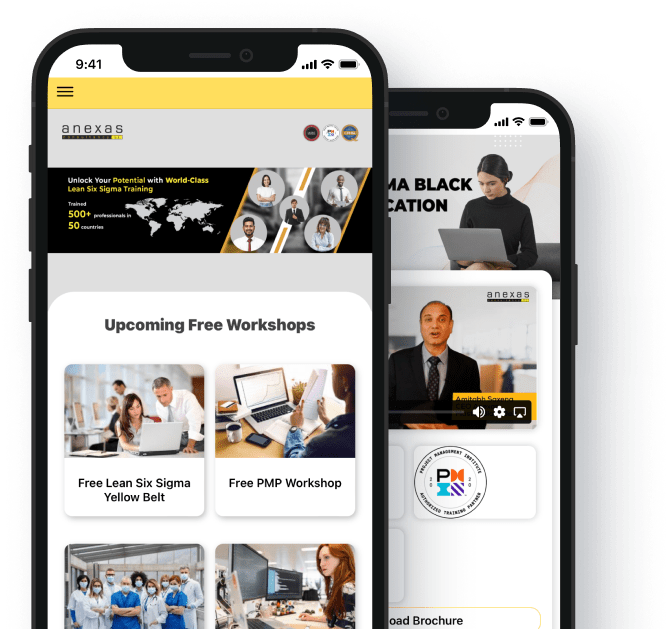Table of Contents
Share This Article
Master Lean Six Sigma: Top 10 Tools You Need to Know
- 27916 views
Lean Six Sigma is a powerful methodology to drive process improvement and achieve operational excellence in organizations. Lean Six Sigma tools form the backbone of Lean Six Sigma. These tools are specifically designed to streamline processes, enhance quality, and foster continuous improvement. By mastering these tools, professionals can effectively identify and eliminate waste, reduce variability, and optimize performance, leading to improved customer satisfaction and increased efficiency.
This article focuses on the top 10 tools of Lean Six Sigma and how they can be used to improve processes. This will help you understand Lean Six Sigma better and use Lean Six Sigma methodology and tools for your career growth.

Join us for the Free Lean Six Sigma Yellow Belt training where you can learn the fundamental tools from Lean Six Sigma experts in a live session.
Introduction to Lean Six Sigma: A Methodology for Process
Lean Six Sigma is a powerful methodology that has revolutionized the world of process improvement. It combines two distinct approaches, Lean and Six Sigma, to optimize efficiency, eliminate waste, and enhance quality within organizations. The Lean principles focus on reducing non-value-added activities and streamlining processes, while Six Sigma techniques aim to minimize defects and variations in outcomes. Together, they form a comprehensive framework that enables businesses to achieve operational excellence, improve customer satisfaction, and drive sustainable growth.
By identifying and addressing the root causes of problems, Lean Six Sigma empowers teams to make data-driven decisions, implement effective solutions, and continuously monitor and refine processes. With its systematic and disciplined approach, Lean Six Sigma has become a go-to methodology for organizations across various industries, setting them on a path towards excellence and continuous improvement.
Why Mastering Lean Six Sigma Tools is Crucial for Business Success
The effective implementation of Lean Six Sigma tools empowers organizations to make data-driven decisions, optimize processes, and maximize customer satisfaction. As a result, businesses gain a significant edge in the market, improve their bottom line, and establish a reputation for operational excellence. The impact of Lean Six Sigma on businesses are:
- Lean Six Sigma tools and techniques provide a systematic approach to process improvement and waste reduction.
- Mastering Lean Six Sigma tools enables businesses to streamline operations and enhance productivity.
- Effective implementation of Lean Six Sigma tools helps minimize defects and deliver high-quality products or services.
- Lean Six Sigma empowers organizations to make data-driven decisions and optimize processes.
- By mastering Lean Six Sigma tools, businesses can maximize customer satisfaction and gain a competitive advantage in the market.
- Lean Six Sigma proficiency contributes to improved profitability and establishes a reputation for operational excellence.
The Top 10 Tools Every Lean Six Sigma Practitioner Should Be Familiar With Tool
For any Lean Six Sigma practitioner, familiarity with the top 10 tools is essential for success. These quality tools in Six Sigma serve as the foundation for process improvement and data-driven decision-making. Being well-versed in these tools allows Lean Six Sigma practitioners to effectively optimize processes, reduce waste, and enhance overall organizational performance. With these tools in their toolkit, practitioners can make a significant impact and drive continuous improvement initiatives. Let us get introduced to the top 10 Lean Six Sigma tools list-
1. Value Stream Mapping
Value Stream Mapping (VSM) is a powerful tool for visualizing and analyzing the flow of processes within an organization. By mapping out the entire value stream, from the input of raw materials to the delivery of the final product or service, VSM provides a comprehensive understanding of the current state of processes. It identifies bottlenecks, inefficiencies, and areas of waste, enabling practitioners to streamline operations and improve overall performance. Through the use of symbols, charts, and data, VSM offers a clear and concise representation of the value stream, facilitating collaboration and communication among cross-functional teams. With VSM, organizations gain valuable insights into process flow, make informed decisions, and drive continuous improvement initiatives for enhanced productivity and customer satisfaction.
2: 5 Whys Analysis
The 5 Whys Analysis is a powerful tool used to uncover the root cause of problems within an organization. By repeatedly asking “why” to dig deeper into the issue, practitioners can peel back the layers of symptoms and identify the underlying cause. This systematic approach helps to reveal the true source of the problem and enables effective solutions using Lean Six Sigma problem-solving tools. The 5 Whys Analysis promotes critical thinking, encourages a deeper understanding of the issues at hand, and facilitates targeted solutions. By addressing the root cause, organizations can implement sustainable and long-lasting improvements, minimizing the chances of recurrence. The 5 Whys Analysis is an invaluable tool for problem-solving and driving continuous improvement efforts.
3: Kaizen Events
Kaizen Events, also known as Rapid Improvement Events, is an effective tool for driving continuous improvement in small, incremental steps within an organization. These focused and time-limited events bring together cross-functional teams to tackle specific challenges or areas for improvement. By applying Lean principles and methodologies, Kaizen Events enable organizations to identify and eliminate waste, streamline processes, and enhance efficiency. These events foster a collaborative environment that encourages team members to brainstorm ideas, implement solutions, and measure the impact of their efforts. Kaizen Events promote a culture of continuous improvement, empowering organizations to make significant progress in a short period. With their structured approach and emphasis on small, achievable steps, Kaizen Events are a valuable tool for organizations seeking to drive meaningful and sustainable change.
4: Kanban System
The Kanban system is a powerful tool for optimizing workflow and reducing waste within organizations. Originating from Lean principles, this visual management system helps teams visualize work in progress, monitor flow, and improve overall efficiency. With the use of Kanban boards and cards, teams can track tasks, identify bottlenecks, and balance workloads effectively. By limiting work in progress and focusing on completing tasks before starting new ones, the Kanban system helps prevent overburdening and improves productivity. This tool also facilitates continuous improvement by highlighting areas for process refinement and waste reduction. By implementing the Kanban system, organizations can achieve a smooth and streamlined workflow, increase team collaboration, and deliver value to customers more efficiently.
5: Poka-Yoke
Poka-Yoke, also known as error-proofing, is a powerful tool used to prevent mistakes and ensure error-free processes within organizations. By employing techniques such as visual cues, checklists, and feedback mechanisms, Poka-Yoke helps eliminate human errors and minimize defects. This tool focuses on designing foolproof systems that make errors impossible or difficult to occur. Whether through physical devices, process modifications, or error-detection mechanisms, Poka-Yoke acts as a safeguard against errors, promoting quality and efficiency. By implementing Poka-Yoke, organizations can enhance product and service reliability, reduce rework and waste, and improve overall customer satisfaction. It is an indispensable tool for organizations aiming to create error-free processes and deliver high-quality outcomes consistently.
6: Pareto Analysis
Pareto Analysis, named after the economist Vilfredo Pareto, is a valuable tool for identifying and prioritizing the most significant issues within an organization. This technique enables practitioners to focus their efforts and resources on the vital few factors that contribute to the majority of problems or opportunities. By applying the 80/20 rule, Pareto Analysis helps distinguish the critical factors from the trivial ones, enabling organizations to allocate resources effectively. Through data visualization and analysis, practitioners can identify the key areas that warrant attention and prioritize their actions accordingly. Pareto Analysis provides valuable insights for decision-making, enabling organizations to address the root causes of issues, optimize processes, and achieve substantial improvements in overall performance. By leveraging the power of Pareto Analysis, organizations can make informed decisions and drive targeted actions to maximize their impact and drive success.
7: Control Charts
Control charts are a powerful tool for monitoring process performance and variability within organizations. These charts provide a visual representation of data over time, allowing practitioners to track the stability and predictability of processes. By plotting data points and establishing control limits, control charts help identify common causes of variation and detect any special causes that may lead to process deviations. This tool enables organizations to proactively manage and improve process performance by taking corrective actions when necessary. Control charts provide valuable insights into process stability, quality control, and continuous improvement efforts. By utilizing control charts, organizations can ensure consistent and reliable outcomes, reduce waste and defects, and enhance overall operational excellence.
8: Failure Mode and Effects Analysis (FMEA)
FMEA is a powerful tool used to assess and mitigate risks within organizations. This systematic approach identifies potential failure modes in processes, products, or services, and evaluates their impact on customers and the business. By analyzing failure modes, their causes, and their effects, organizations can proactively take preventive measures and implement appropriate mitigation strategies. FMEA helps organizations prioritize their efforts by focusing on high-risk areas and allocating resources effectively. This tool promotes a culture of risk management and continuous improvement, ensuring that potential failures are addressed before they occur. By leveraging FMEA, organizations can enhance quality, customer satisfaction, and overall business resilience.
9: 5S Methodology
The 5S methodology is a powerful tool for organizing and streamlining the workplace within organizations. This structured approach focuses on five key principles: Sort, Set in Order, Shine, Standardize, and Sustain. By implementing these principles, organizations can create a clean, efficient, and safe working environment. The 5S methodology helps eliminate clutter, reduce waste, and improve overall productivity. It establishes a systematic approach to storage, layout, and cleanliness, ensuring that everything has a designated place and is easily accessible. Standardizing processes and sustaining the 5S practices promote consistency and continuous improvement. By embracing the 5S methodology, organizations can enhance efficiency, employee morale, and overall workplace effectiveness.
10: Cause and effect diagram
A cause and effect diagram, also known as a Fishbone diagram or Ishikawa diagram, is a valuable tool used to identify and understand the root causes of a particular problem or issue. This diagram provides a visual representation of the various factors that contribute to an outcome or effect, helping individuals and teams analyze complex situations and determine the underlying causes. The diagram consists of a horizontal line representing the effect or problem being investigated, with several lines branching off like the bones of a fish. Each branch represents a different category of potential causes, such as people, processes, materials, equipment, or environment. By systematically exploring these categories and identifying specific causes within each one, the cause-and-effect diagram allows for a comprehensive analysis that can lead to effective problem-solving and process improvement.
Tips for Mastering Lean Six Sigma Tools Effectively
- Understand the Purpose: Gain a deep understanding of each Lean Six Sigma tool and its purpose. Learn how it contributes to process improvement, waste reduction, and problem-solving. This knowledge will help you select the right tool for each situation.
- Invest in Training: Seek formal training and certification in Lean Six Sigma methodologies. This will provide you with the necessary knowledge and skills to effectively apply the tools. Continuous learning and professional development will help you stay updated with the latest industry practices.
- Start Small: Begin by applying Lean Six Sigma tools to smaller projects or processes. This allows you to practice and refine your skills before tackling larger and more complex initiatives. Starting small also helps build confidence and generates quick wins, motivating you to continue applying the tools.
- Collaborate with Cross-Functional Teams: Lean Six Sigma is most effective when applied by cross-functional teams. Collaborate with individuals from different departments and backgrounds to leverage their expertise and gain diverse perspectives. This collaboration promotes buy-in, enhances problem-solving capabilities, and fosters a culture of continuous improvement.
- Focus on Data-Driven Decision Making: Emphasize the importance of data collection and analysis in Lean Six Sigma projects. Use appropriate statistical tools and techniques to validate hypotheses and make informed decisions. Data-driven insights provide evidence-based recommendations for process improvements.
- Communicate Effectively: Effective communication is crucial when implementing Lean Six Sigma tools. Clearly communicate the purpose, benefits, and expectations of using the tools to all stakeholders. Use visual aids, such as charts and diagrams, to simplify complex concepts and facilitate understanding.
- Practice Regularly: Like any skill, mastering Lean Six Sigma tools requires practice. Look for opportunities to apply the tools in your daily work. Continuously seek feedback and reflect on your application of the tools to identify areas for improvement.
- Embrace a Continuous Improvement Mindset: Lean Six Sigma is not a one-time project; it is a mindset and a way of working. Foster a culture of continuous improvement within your organization by encouraging feedback, celebrating successes, and continuously seeking ways to optimize processes.
- Document and Share Best Practices: Keep a record of successful Lean Six Sigma projects and their outcomes. Document the methodologies and tools used, along with lessons learned. Sharing these best practices with your team and organization helps create a knowledge-sharing culture and promotes consistent application of the tools.
- Stay Engaged and Motivated: Lean Six Sigma requires dedication and perseverance. Stay engaged and motivated by celebrating successes, recognizing team efforts, and acknowledging the positive impact of process improvements. Regularly review the benefits achieved to reinforce the value of Lean Six Sigma and inspire ongoing commitment.
Overcoming Common Challenges When Implementing Lean Six Sigma Tools
Implementing the most popular Lean Six Sigma tools and techniques can present common challenges that organizations must overcome to achieve success. Resistance to change, lack of leadership support, absence of a data-driven culture, and unrealistic expectations can hinder progress. However, by embracing effective change management strategies, engaging leaders, promoting data literacy, and setting realistic goals, organizations can overcome these hurdles. With perseverance and a proactive approach, the benefits of Lean Six Sigma can be fully realized, leading to improved processes, reduced waste, and enhanced performance.
You can master the use of Lean Six Sigma tools in the Lean Six Sigma Green Belt Training and Certification Course and start your journey towards leadership roles.
Conclusion
Mastering the top 10 Lean Six Sigma tools is a game-changer for organizations aiming to achieve operational excellence. These quality tools in Lean Six Sigma provide a systematic approach to process improvement, waste reduction, and problem-solving. By understanding the purpose of each tool, investing in training, and starting small, professionals can gradually build their expertise and confidence.
Collaboration with cross-functional teams, data-driven decision-making, and effective communication are key to successful implementation. Embracing a continuous improvement mindset and documenting best practices foster a culture of excellence. While challenges may arise during implementation, overcoming resistance to change, securing leadership support, promoting a data-driven culture, and setting realistic expectations are crucial steps.
By mastering the most popular Lean Six Sigma tools and leveraging their power, organizations can drive sustainable improvements, enhance customer satisfaction, and achieve a competitive edge in today’s dynamic business landscape.
FAQs for Lean Six Sigma tools
What is Lean Six Sigma?
Lean Six Sigma is a methodology that combines the principles of lean manufacturing (focused on eliminating waste) and Six Sigma (focused on reducing process variation) to achieve operational excellence and improve overall business performance.
What are the top 10 Lean Six Sigma tools?
The top 10 Lean Six Sigma tools are Value Stream Mapping, 5S Methodology, Kaizen Events, DMAIC (Define, Measure, Analyze, Improve, Control), Poka-Yoke, Kanban System, Cause and Effect Diagram, Pareto Analysis, Statistical Process Control, and Lean Tools (Just-in-Time, Standard Work, etc.).
How do I choose the right tool for a specific problem?
Choosing the right tool involves understanding the problem at hand, identifying its root causes, and considering the nature of the process. Each tool has its specific purpose, so select the one that aligns best with the problem you are trying to solve or the goal you want to achieve.
Is it necessary to undergo Lean Six Sigma training to use these tools effectively?
Formal Lean Six Sigma training provides a comprehensive understanding of the tools, methodologies, and statistical techniques involved. While it is not mandatory, training enhances your ability to apply the tools effectively and ensures you have a strong foundation in Lean Six Sigma principles.
How can cross-functional teams contribute to the effective use of these tools?
Cross-functional teams bring diverse perspectives and expertise to the table. Collaborating with team members from different departments ensures a holistic approach to the solution using Lean Six Sigma problem-solving tools and allows for a comprehensive analysis of processes, leading to better outcomes.
What role does data play in Lean Six Sigma tools?
Data is vital in Lean Six Sigma as it provides objective insights into process performance and helps identify areas for improvement. These tools rely on data analysis to make informed decisions and validate the effectiveness of process improvements.
How can I overcome resistance to change when implementing these tools?
Resistance to change is common when introducing new methodologies. Effective change management strategies such as clear communication, involving employees in decision-making, and highlighting the benefits of Lean Six Sigma can help overcome resistance and foster buy-in.
How long does it take to master Lean Six Sigma tools?
Mastering Lean Six Sigma tools is an ongoing journey. The timeline varies depending on individual dedication, prior experience, and the complexity of the projects undertaken. Continuous learning, practice, and application of the tools will contribute to mastery over time.
Can Lean Six Sigma tools be applied in industries other than manufacturing?
Absolutely! Lean Six Sigma tools have proven successful in a wide range of industries, including healthcare, service, finance, and technology. The principles and tools can be adapted and applied to any process-oriented environment.
What are the benefits of mastering these tools?
Mastering Lean Six Sigma tools allows organizations to optimize processes, reduce waste, improve quality, increase customer satisfaction, and achieve cost savings. It empowers individuals and teams to drive continuous improvement and deliver measurable results for their organization.






